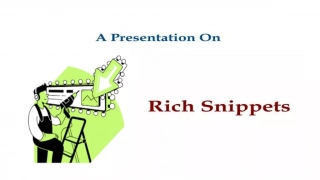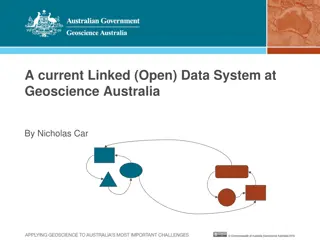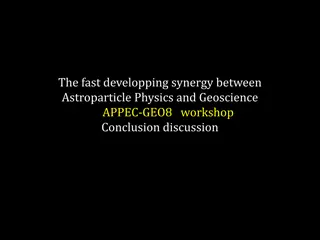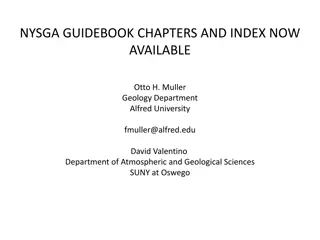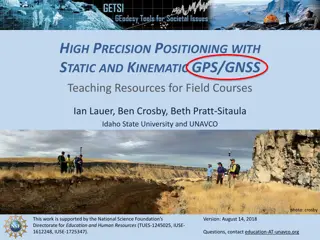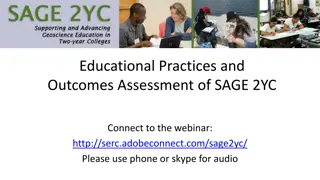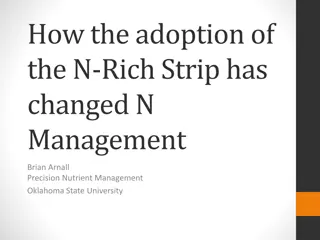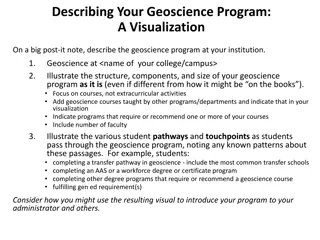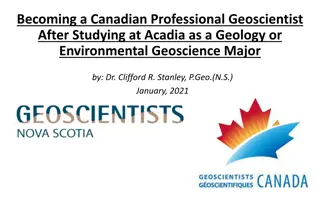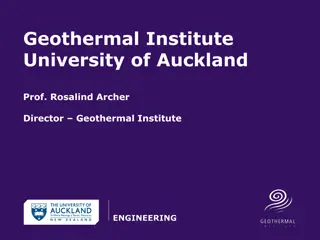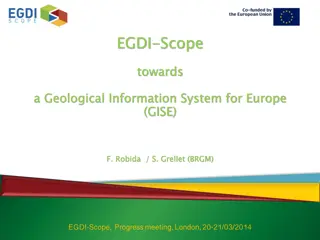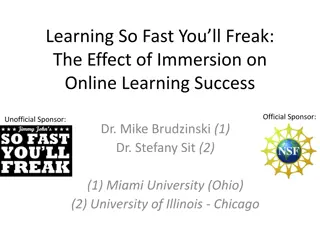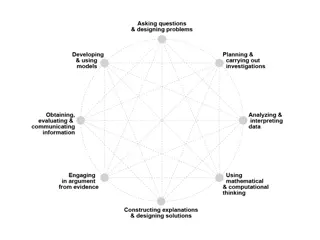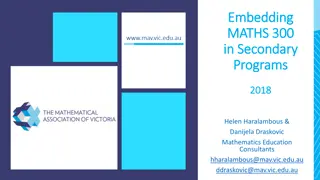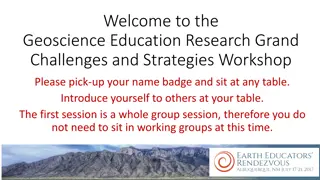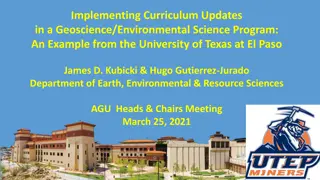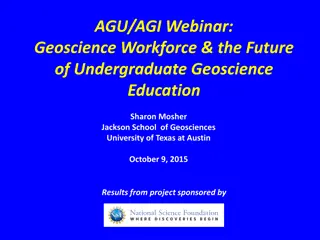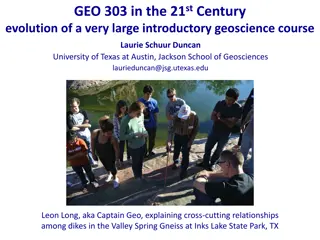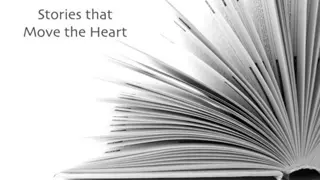Enhancing Geoscience Education with Data-Rich, Societally Relevant Resources
Explore a collaborative project focused on developing teaching materials for geoscience classrooms and field courses. Supported by NSF grants, the project aims to improve undergraduate STEM education by emphasizing geodesy data and quantitative skills applied to societal issues like climate change and natural hazards. Partnerships with educational institutions and organizations enhance the creation of modules for introductory and majors-level courses. Embrace the importance of integrating real-world applications to increase student engagement and address pressing societal challenges.
Download Presentation

Please find below an Image/Link to download the presentation.
The content on the website is provided AS IS for your information and personal use only. It may not be sold, licensed, or shared on other websites without obtaining consent from the author.If you encounter any issues during the download, it is possible that the publisher has removed the file from their server.
You are allowed to download the files provided on this website for personal or commercial use, subject to the condition that they are used lawfully. All files are the property of their respective owners.
The content on the website is provided AS IS for your information and personal use only. It may not be sold, licensed, or shared on other websites without obtaining consent from the author.
E N D
Presentation Transcript
DATA-RICH SOCIETALLY-RELEVANT UNDERGRADUATE TEACHING RESOURCES FOR GEOSCIENCE CLASSROOMS AND FIELD COURSES Beth Pratt-Sitaula (UNAVCO) Bruce Douglas (University of Indiana) Becca Walker (Mt San Antonio College) Benjamin Crosby (Idaho State University) Donna Charlevoix (UNAVCO) Chris Crosby (UNAVCO) Katherine Shervais (UNAVCO) Meghan Miller (UNAVCO) This work is supported by the National Science Foundation s Transforming Undergraduate Education in STEM (DUE-1245025) and Improving Undergraduate STEM Education DUE-1612248) within the Directorate for Education and Human Resources.
GETSI PROJECT OVERVIEW Mission: Develop and disseminate teaching and learning materials that feature geodesy data & quantitative skills applied to critical societal issues such as climate change, water resources, and natural hazards Classroom oriented NSF TUES (Transforming Undergraduate Education in STEM) UNAVCO, Mt San Antonio College, and Indiana University Field oriented NSF IUSE (Improving Undergraduate STEM Education) UNAVCO, Indiana University, Idaho State University Partnership with SERC and NAGT Developing seven modules (~2 weeks each) Introductory & Majors-level
GETSI-INTEGRATE PARTNERSHIP Module development and assessment following model of SERC s InTeGrate Project (NSF STEP)
Solving societal challenges Increasing student STEM engagement Complementary paths to improvement
SOCIETALLY-RELEVANT STEM LEARNING Examples National Research Council 2015. Reaching Students: What Research Says About Effective Instruction in Undergraduate Science and Engineering PCAST. 2012. Engage to Excel: Producing One Million Additional College Graduates with Degrees in Science, Technology, Engineering, and Mathematics. Project Kaleidoscope. 2006. Transforming American s Scientific and Technological Infrastructure Recommendations for Urgent Action: Report on Reports II. National Academy. 2010. Rising above the Gathering Storm, Revisited: Rapidly Approaching Category 5. Bralower, Timothy J, P. Geoffrey Feiss, and Cathryn A. Manduca. 2008. Preparing a New Generation of Citizens and Scientists to Face Earth s Future.
WHY GEODESYFOR STUDENTS? Topics align well with Earth Science and Climate Literacy Principles Real world applications are shown to increase interest and learning Discovery learning data analysis can increase critical thinking skills and quantitative skills Measurement are on a human timescale Earth science majors are often not learning about these critical research techniques
GEODESYIS the science ofaccurately measuring the Earth s size, shape, orientation, mass distribution and the variations of these with time. Traditional geodesy: Precise positioning of points on the surface of the Earth Modern geodesy: A toolbox of techniques to better measure the Earth wikipedia.org JPL/NASA 7
UNPACKINGTHE GEODESY TOOLBOX GPS (Global Positioning System) InSAR (Interferometric synthetic aperture radar) LiDAR (Light detecting and ranging) Structure from Motion Strain meters, tiltmeters, creep meters Gravity measurements Sea level altimetry Sea level altimetry GPS (Global Positioning System) InSAR (Interferometric synthetic aperture radar) LiDAR (Light detecting and ranging) Structure from Motion Strain meters, tiltmeters, creep meters Gravity measurements usgs.gov http://www.nasa.gov/topics/earth/features/graceImg20091214. html www.jpl.nasa.gov http://photojournal.jpl.nasa.gov/catalog/PIA00557 http://facility.unavco.org/data/maps/GPSVelocityViewer/GPSVe locityViewer.html http://www.iris.edu/
PUBLISHED MODULES serc.carleton.edu/getsi or search serc and getsi Images: Michael Bevis & NASA/JPL/UCDAvis
UPCOMING MODULES 2016 High Resolution Topography (Field) Bruce Douglas (Indiana U) Kate Shervais (UNAVCO) & others GPS, Strain & Earthquakes (Majors) Vince Cronin (Baylor) Phil Resor (Wesleyan) Measuring Water Resources (Majors) Bruce Douglas (Indiana U) Eric Small (U of Colorado) Surface Process Hazards (Intro) Becca Walker (Mt SAC) Sarah Hall (College of Atlantic) Images: N. Niemi, UNAVCO, CA Water Board, USGS
MODULECOMPONENTS & DEVELOPMENTPROCESS Guiding Principles Address one or more geodesy-related grand challenges facing society Make use of authentic and credible geodesy data Improve student understanding of the nature and methods of geoscience Develop student ability to address interdisciplinary problems and apply geoscience learning to social issues Increase student capacity to apply quantitative skills to geoscience learning learning Guiding Principles Address one or more geodesy-related grand challenges facing society Make use of authentic and credible geodesy data Improve student understanding of the nature and methods of geoscience Develop student ability to address interdisciplinary problems and apply geoscience learning to social issues Increase student capacity to apply quantitative skills to geoscience Images: B. Douglas, USGS, N. Niemi, GETSI, CU Sea level group
MODULECOMPONENTS & DEVELOPMENTPROCESS Module development criteria codified in Materials Development Rubric Identify module learning goals Pilot Materials Revise Identify unit learning outcomes Plan instruction strategies Design teaching materials to match assessment Determine assessment strategy serc.carleton.edu/integrate
GPS, STRAIN & EARTHQUAKES Unit 1 Earthquake Unit 2 Physical Models Unit 3 Getting started with GPS data Unit 4 GPS & strain analysis Unit 5 South Napa Earthquake Unit 6 Applying strain and earthquake hazard analyses to different regions Student select own area of interest and analyze for strain and earthquake hazard Images: V. Cronin, NOAA
ANALYZING HIGH RESOLUTION TOPOGRAPHYWITH TLS AND SFM Unit 1 Intro to surveying Unit 2 Stratigraphy application Unit 3 Fault scarp application Unit 4 Change detection Unit 5 Summative Final Project Students design and carry out own survey to address geoscience research question
FINDINGS Overall InTeGrate model works well Development Rubric pinpointed weaknesses in module components Student testing pinpointed gaps in alignment and student accomplishment Testers report higher student engagement Students accomplish the learning goals including more discovery-based projects Some challenges and solutions
DATA-RICH CURRICULUM DEVELOPERS MANUAL Challenges & Solutions Image reuse permission very time consuming More author coaching and staff time Team functionality varies No single solution but structured communication about work styles, module progress, and work delegation helps Design for future instructors ease of use Non-author pilot testers to help pinpoint oversights
DATA-RICH CURRICULUM DEVELOPERS MANUAL Key element is three-fold expertise Instructional Pedagogy and assessment Technical and data processing
NEXT STEPS Initial dissemination of GETSI Phase I materials via in-person and virtual venues Research into module adaption/adoption meta pilot-testers give feedback on actual use GETSI Phase II More classroom modules developed Expand to include field education geodesy methods Much more dissemination and continued research into adaption/adoption Expand user base outside geoscience (civil engineering & environmental/bio science)
SHORT COURSE AGU 2016 Sunday December 11 8 5 pm San Francisco, CA $300 stipend bit.ly/agu16-unav Deadline Nov 1, preference to applications received October 1 InSAR, GPS, Lidar, SfM


